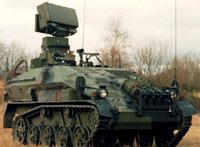Fire-control Radar or Tracking Radar
A Fire-control radar or tracking radar measures the coordinates of a target and provides data which may be used to determine the target trajectory and to predict its future position. These radars provide continuously position data on a single target. Most tracking radar systems used by the military are also fire-control radar; the two names are often used interchangeably.
There are two types of tracking:
- Track-while-scan
Here the radar is in the surveillance mode and attempts to form tracks of detected targets. In this way, multiple targets may be tracked. The radar uses an antenna that makes use of the monopulse concept. - Continuous trackers
Here the radar is dedicated to the tracking function. A surveillance radar might provide coordinates for the tracker radar. In this way, a single target is tracked only. These radars may also use the older method of the conical scan.
Typical continuous tracker radar characteristics include a very high pulse repetition frequency (PRF), a very narrow pulse width, and a very narrow beamwidth. These characteristics, while providing extreme accuracy, limit the range and make initial target detection difficult.
Fire-control radar must be directed to the general location of the desired target because of the narrow-beam pattern. This is called the designation phase of equipment operation. Once in the general vicinity of the target, the radar system switches to the acquisition phase of operation. During acquisition, the radar system searches a small volume of space in a prearranged pattern until the target is located. Once the target is located, the radar system enters the track phase of operation. Using one of several possible scanning techniques, the radar system automatically follows all target motions. The radar system is said to be locked on to the target during the track phase. The three sequential phases of operation are often referred to as modes and are common to the target-processing sequence of most fire-control radars.
Track-while-scan is a method of combining search and track functions. This radar can track multiple targets. This method is used in Air-Traffic-control radars by using information from secondary radar. (Their precise function is explained in the section radar signal processing.) Surveillance radars in air defense applications cannot use these secondary radar information. These radars search for targets and whenever a target is detected then the radar estimates the target's range, range-rate, azimuth angle, and elevation angle. After successive scans, the radar accumulates accurate tracks of targets.
The radar can then estimate a safe course for this target (in the case of civil aviation safety), or (in the case of a military application) the point to direct the weapon onto this aim using the necessary deflection.

